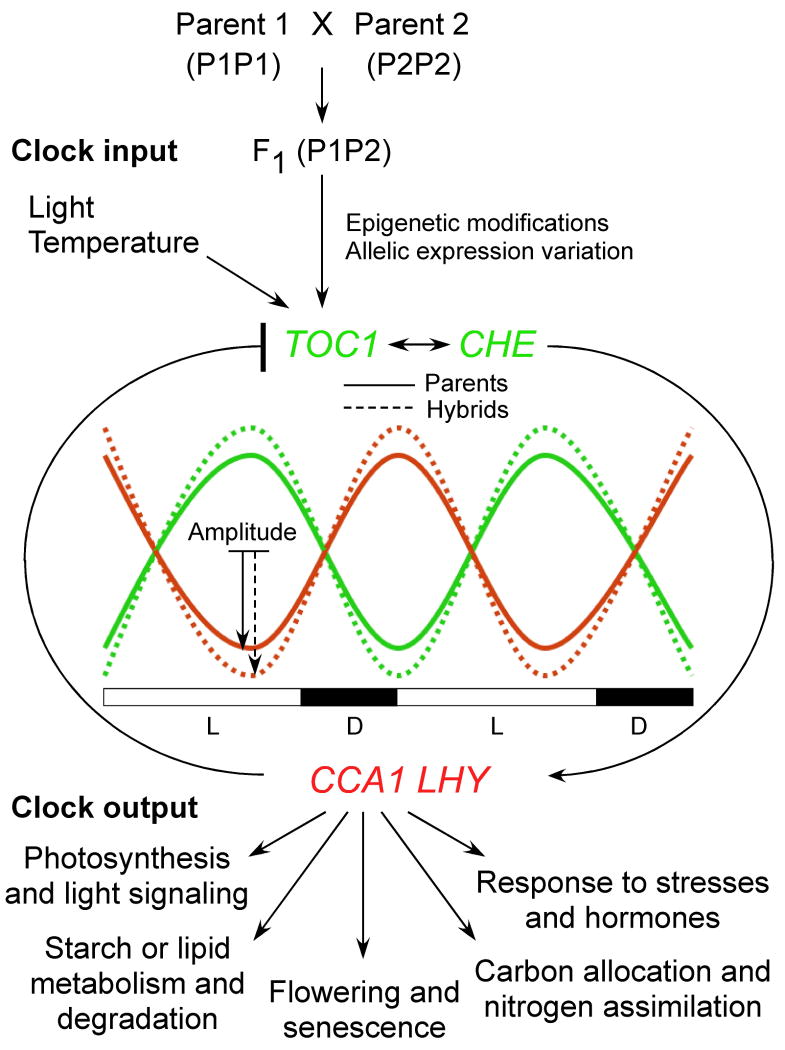Figure 3.
Growing around the clock: a molecular mechanism for hybrid vigor. A molecular clock model explains the basis of heterosis. The internal clocks of plants are controlled by multiple feedback loops, including a major loop that consists of two transcription repressors CCA1 and LHY with redundant but incompletely overlapping functions and feedback regulators TOC1 and CHE (see Box 1). The clock receives input signals such as lights and temperature and controls output traits and pathways, including photosynthesis and light signaling, flowering, starch biosynthesis and metabolism, responses to stresses and hormones, and carbon allocation and nitrogen assimilation, through the expression of evening element (EE) or CCA1 binding site (CBS)-associated genes. The expression amplitude and periodicity of circadian clock regulators can be changed or fine-tuned in response to input (external) signals such as light and temperature, as well as internal mechanisms such as allelic expression variation. L and D indicate the length of light (L) and darkness (D) in a circadian cycle. In the hybrids, the allelic interactions between parent 1 (P1) and parent 2 (P2) induce epigenetic repression of CCA1 and LHY expression amplitudes (red dashed line) and upregulation of TOC1 expression amplitudes (green dashed line) relative to the expression values in the parents (solid red and green lines, respectively), whereas the periodicity of the clock remains the same [101] because maintaining clock periodicity and rhythm is important for plant growth and fitness [84]. The reduced amount of CCA1 repressors in the hybrids during the day induces the expression of circadian-clock-associated genes (CCGs) in various output pathways, including chlorophyll biosynthesis and starch metabolism and degradation. As a result, the hybrids produce more chlorophyll and starch than the parents, which promotes vegetative growth and morphological vigor. The CCA1 expression amplitude is regulated by chromatin modifications, where the levels of active histone marks are reduced during the day and increased at night. The hybrid-induced changes in the CCA1 expression amplitude are reminiscent of expression alterations in response to changes in input signals such as light (intensities) and temperature. The clock modulates auxin signaling and responses [141]. In addition, the output pathways also produce feedback regulation for the internal clocks. For example, circadian oscillator regulation requires organic nitrogen signals [142] and free cytosolic Ca2+ [143]. Allelic interactions in the hybrids induce superior performance of physiological pathways for chlorophyll biosynthesis and starch metabolism. The overdominant performance is caused by epigenetic repression (nonadditive expression) of a key regulator in the feedback loop of the clock oscillator, which mediates the downstream genes in chlorophyll biosynthesis and starch metabolism. Clock-mediated heterosis is probably universal because internal clocks mediate physiological and metabolic pathways in plants and animals. Moreover, this model can be extrapolated to explain superior traits of many other biological pathways.

